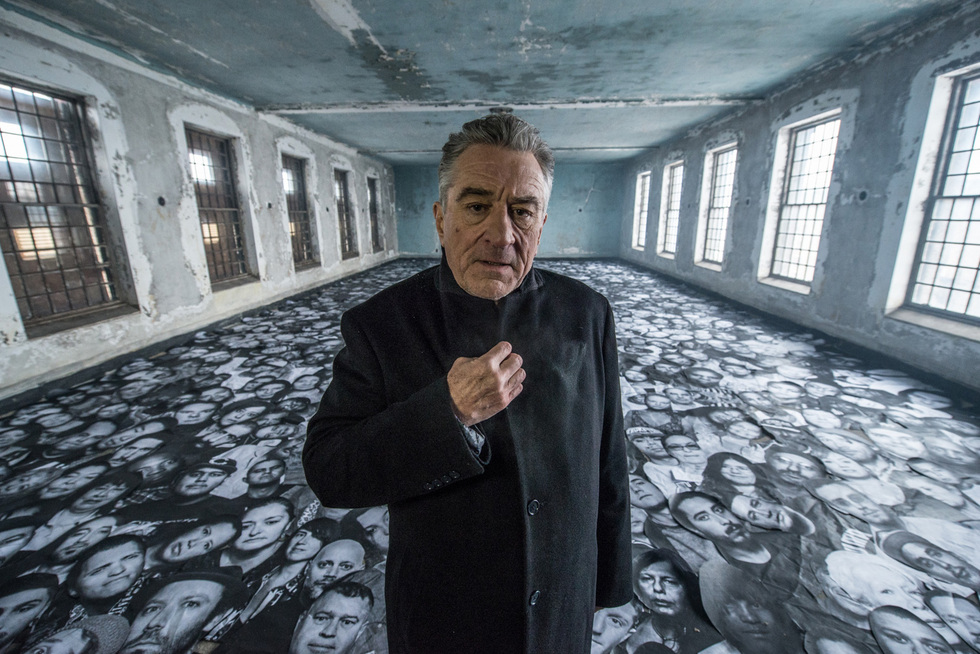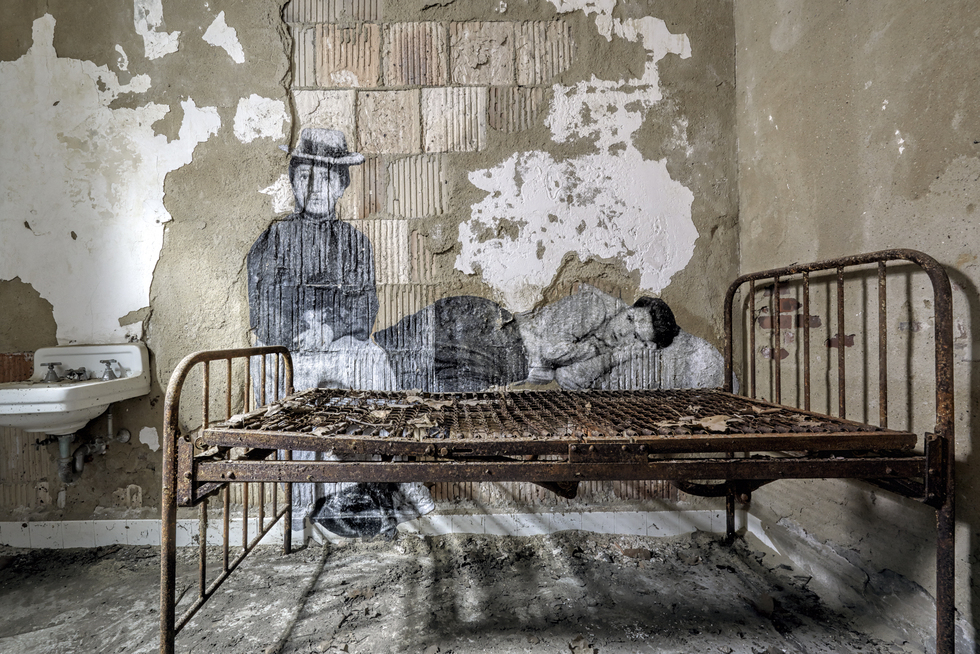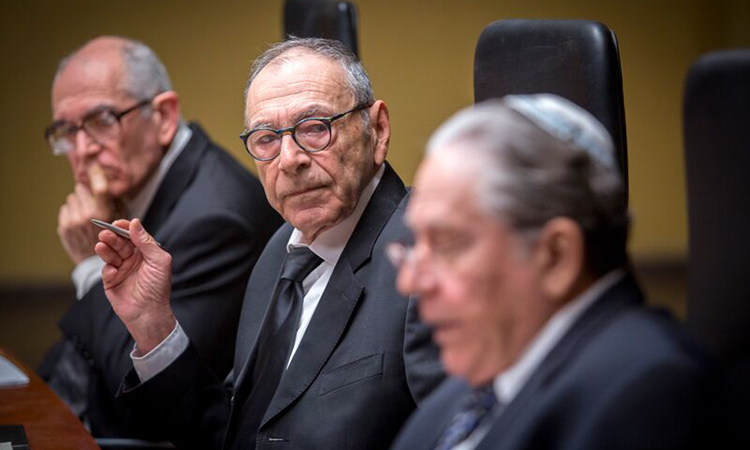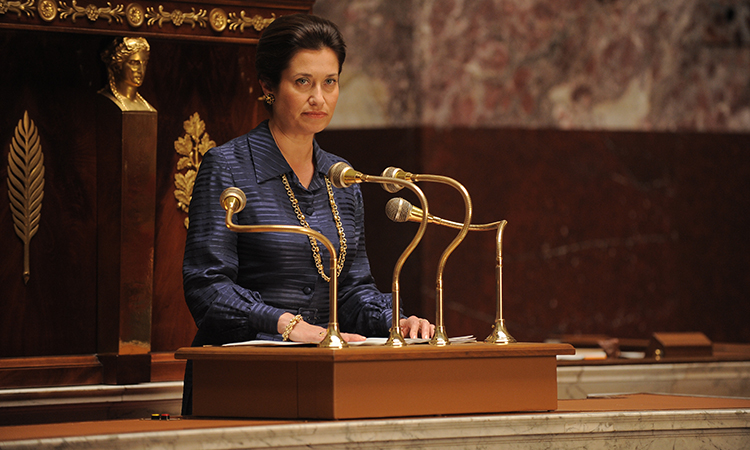New York Jewish Film Festival 2016 – Critic’s Choices

NYJFF co-presenters, the Jewish Museum and the Film Society of Lincoln Center, celebrate 25 years.
Senior film critic Kurt Brokaw chooses his favorites from the 25th edition of the New York Jewish Film Festival, which runs January 13-26, 2016.
Ellis
(JR. USA. 2015. 14 min.)
“Mama left a note in my suitcase to do something that would make her proud—to be a good man.”
—Robert De Niro, in Ellis
What better way to announce the 25th anniversary of one of the New York’s most admired film festivals than by saluting a work of art that’s not even among its 38 features from 12 countries. Ellis is a short, and at 14 indelible and mesmerizing minutes not even a long short—one of a dozen brief films curated as part of the New York Jewish Film Festival by the Film Society of Lincoln Center and The Jewish Museum, all of which this writer has viewed with the keenest interest.
In a season of raging cultural wars over the issue of immigration, coupled with stormy warnings by politicians of sealing borders both nationally and internationally, what could be more relevant—and more representative of the Jewish experience—than a walk-through the Ellis Island Immigration Hospital, still standing in stately ruins next to New York Harbor 86 years after its closing.
This is no ordinary walk-through, and its flaking walls bear the burning imprint of the 12 million women, men, and children who arrived at Ellis Island as their gateway to America between 1892 and 1954. America’s first public health hospital was an examination site starting in 1902 through 1930, where all who desired entry were checked for typhoid, diphtheria, cholera, malaria, hookworm, tuberculosis and other maladies.
It was a full teaching hospital with a first-rate operating theater—New York’s pioneering urban defense against contagious diseases, at a time when penicillin and antibiotics didn’t exist. Nearly 10 percent of the immigrant population were detained and treated—3,500 passed away during their stay at Ellis—and one to two percent were sent back to their country of origin.
While the hospital’s treatment of immigrants was largely compassionate (355 babies were born there), its history is also tainted by a leaning toward eugenics in the 1920s that judged desperately poor people by their appearance, language, dress and employment potential. Those few who crossed in first class rarely had detention issues; those who came over in steerage—and most did—were scrutinized far more carefully. Many newcomers were terrified of X-rays and “short-arm inspections,” and were afraid to shed their clothes for physical exams, because the little money they brought was sewn into the linings of their clothing. This hospital has a dark history as well.

Enter JR, the street artist known in worldwide shorthand as the French Banksy (though he might more accurately be termed the Anselm Kiefer of facial photography). The work, much of it shot with a 28mm wide-angle lens, splays out in vast outdoor settings where time and nature will eventually surround and consume it. JR (he says his initials stand for his name) is 33 and freely appears in public, unlike his British counterpart. He’s of Tunisian and Eastern European ancestry, and his specialty is flyposting black-and-white montages of faces throughout the world.
Locally, the artisan has created huge wall and sidewalk blowups of recent immigrants’ faces for the New York Times’ “Walking New York” series, and a 6,500 square foot trompe l’oeil photo of 81 New York City Ballet dancers posed in the shape of an eye. He directed and choreographed an uneasy but soaring 17-minute short film, Les Bosquets, shot in and around a housing project in a Parisian suburb, which was shown at last spring’s Tribeca Film Festival.
Enter Tribeca co-founder and veteran producer Jane Rosenthal. Perhaps sensing a potential creative opportunity, Rosenthal sent JR a photo book on Ellis Island and its hospital. “America is a nation of immigrants,” she’s said, adding, “as new generations were born, some of us forgot how America was made and history proved an unreliable narrator. This is the area where art can fill the gap, illuminate the experience and create the conversation.”
JR sparked to the Ellis Island history and was given permission to dramatize and honor the hospital setting by wheatpasting collaged photos of immigrants on its crumbling walls, stairs and windows. That installation, Unframed-Ellis Island, is now a permanent part of the hospital and the background for Ellis, which had its first New York showing last October and has been available on iTunes in nearly 100 countries since November. Rosenthal and JR produced.
Enter Tribeca co-founder Robert De Niro, who plays a docu-dramatized immigrant, voice-overing his experience at the hospital. He’s scripted by Eric Roth (The Insider, Munich, Forrest Gump) who’s crafted a meditation for De Niro on one man who didn’t make it to the promised land. De Niro is marvelous. At long last, his face is beginning to take on the look of granite chiseled out of a wild cliff. Lou Reed’s face in close up had that look when he made his short film talking with his 101-year-old cousin, Red Shirley.
JR’s camera prowls the hospital’s corridors and rooms with their broken furniture and rusted sinks as De Niro, carrying his one suitcase, tells of his rejection by the doctors, who order him back. “Back where?” he murmurs, answering, “back where you came from.” But he hides in a closet, and then somewhere else, for a week, a month; he meets a girl, who’s also been rejected, and they stand on the shore together, looking at New York’s whited-out skyline as snow falls.
And they try and swim to the city, but the girl doesn’t make it, and he has to release her body into the water. “I am the ghost of all those who never got there,” intones De Niro, making his way across a floor of hundreds and hundreds of JR’s pasted-down immigrant faces that look up and out and rarely, all too rarely ever smile. The camera follows him out to the shoreline and a Manhattan, barely visible, so close yet worlds away as snow blankets the harbor.
Ellis is a film to cherish.
Ellis shows as part of the Shorts Program, Sun., Jan. 24th at 8:30 pm at the Elinor Bunin Monroe Theaters.
Rabin, The Last Day
(Amos Gitai. 2015. Israel/France. 153 min.)
“I don’t think there was a conspiracy. I think it was written on the wall.”
—Amos Gitai
If Ellis is the superior 14-minute short-form docudrama of one soul lost in the tide of immigration, Gitai’s two-and-a-half hour docudrama, Rabin, The Last Day, of the 1995 assassination of Israeli Prime Minister Yitzhak Rabin is the long-form must-see.
Gitai first explored the subject in his 1996 film Territories: Arena of Murder, documenting grieving responses to the murder of the Nobel Peace Prize winner and advocate of cooperative solutions to the Israeli-Palestinian conflict. This time around, the filmmaker, 65, has the skills and perspective of a world class director, as well as a substantial budget, and he’s crafted a political thriller that frames the tragedy in one clear question:
Why did Israel’s Supreme Court spend four endless months methodically examining every “functional failure” of security surrounding Rabin, when his country’s religious fundamentalists had spent five whole years growing and grooming every variety of radical militant and extremist, one of whom would inevitably attempt the ultimate act of revenge?

Gitai dwells intensively on the interrogations and testimony of witnesses before the distinguished Shamgar Commission (headed by Supreme Court president Meir Shamgar) which are taken direct, word for word, from the unpublished protocols of the state commission. They occupy the lion’s share of the movie and everything is acted; the casting and performances are more than competent, like compelling courtroom dramas you’re accustomed to viewing.
The commissioners grow uncomfortable and testy, pointing increasingly frustrated, stern and even accusing fingers at each witness. They’re methodically searching for guilty parties in what appears to have been a systemic failure of security measures: Rabin’s walk to his car adjacent to city hall, coming from a rally in Tel Aviv through a packed crowd in a supposedly ‘sterile zone’ (i.e., free of concealed weapons) the car transporting the mortally wounded leader taking eight-plus minutes to cover less than a mile to Ichilov hospital. These are two of many issues combed by the commission.
Wrong agenda, says Gitai’s film. The commission should have spent four months examining the escalation of hate and confrontation that started immediately after Rabin’s Oslo peace accords surrendered territories (Jericho, parts of the Gaza Strip) that were sacrosanct to many settlers. Gatai’s 1996 film postulated that idea, but Rabin, The Last Day’s suspenseful cross-cutting nails it home: Rabin should have seen it coming.
So should the police, the General Security Service (GSS) and Israel’s elite Shin Bet, the equivalent of our secret service. The assassin got nearly close enough to touch the prime minister before he fired three bullets from a semi-automatic pistol, two of which struck Rabin. Following the commission’s investigation, Shin Bet’s director as well as the GSS security head and the chief of Rabin’s personal security unit either resigned or were dismissed.
This compare-and-contrast method makes for a very long movie that’s never less than eerily absorbing. Some of the build-ups of anger are documentary footage, some are re-creations. Rabin’s real-life, 25-year-old assassin, Yigal Amir, is played with moody, studied assurance by the handsome Yogev Yefet. He’ll strike you as another bright young radicalized zealot who attended enough Likud protests and heard enough screamed death curses that he snapped. (Rabin received one of these ‘pulsa dinura’ death threats only a month before his murder.)
Still, Gitai doesn’t probe Amir’s motivations very deeply, nor does he give much attention to an alleged conspirator within Shin Bet, an agent who supposedly knew Amir. The commission ruled there was no conspiracy link between Amir and any agent. Thus it was in all likelihood “the writing on the wall,” as Gitai has put it, that led directly to Rabin’s last day.
“There’s a violent, Jewish religious underground in the heart of Israeli secular society today,” the director has warned. It’s not hard to fathom why NYJFF’s curators passed on this film as an opening night tent pole for their 25th anniversary festival in favor of Lamb, a slim, unequivocally safe tale of an appealing Ethiopian boy (whose mother is Jewish) and his even more appealing lamb. But Rabin, The Last Day is the one that’s torn from 20th century headlines that still resonate powerfully today. And like Ellis, its topicality puts it top-of-mind.
Rabin, The Last Day shows Sat., January 16th at 9:30 pm and Sun., January 17th at 12:45pm at the Walter Reade Theater.
Dear God
(Guy Nattiv & Erez Tadmor. 2014. Israel. 13 min.)
American newspapers in the early 20th century employed “sob sisters” to write human interest stories with a sentimental, female leaning. They gave rise to newspaper agony columns that dished out advice to readers in matters of love and marriage.

In Jerusalem, the western wall of the Temple Mount came to be known in the 1960s—probably more to visiting Americans than to native Israelis—as the “wailing wall” where female worshipers could follow an ancient tradition of tucking notes to God in the holy drones of the wall.
With Dear God, Guy Nattiv, working with co-director Erez Tadmor, has contributed a sweetly touching modern-day tale of how prayers are answered. An attractive woman in conservative dress (Reymond Amsalem) approaches the wall. She’s watched closely by a neatly uniformed guide, Aaron (Lior Ashkenazi), as she carefully wedges her note into the wall.
Later that night, Aaron, whose job each night is to remove the day’s notes and bag them for proper disposal, reads her note. She writes to God that she’ll be 42 in two days and “yet no one has ever brought me a flower.” She leaves her address on Chabot Street. The next day, she wakes up to a gorgeous bouquet left by Aaron on her doorstep.
She returns to the wall, leaving a note thanking God and musing that “no one has ever dedicated a song to me—how could that be?” We watch Aaron the following morning tote an antique Victrola to the roof of her building, where he plays a classical 78 rpm record and she awakens with a wondrous smile. For a second, she spots him looking down from the roof.
Probably she’s wishing this man will find his way into her life. And with the great Louis Armstrong murmuring his wistful version of Le Vie En Rose on the soundtrack, how could her fondest wish not come true?
Dear God shows along with Ellis in the Shorts Program, Sun., January 24th at 8:30 pm in the Elinor Bunin Monroe Theaters.
The Law
(Christian Faure. 2015. France. 90 min.)
Though they bring fresh new perspectives to vastly different historical moments, Rabin, The Last Day and The Law share similar cinematic trajectories. Rabin begins with the moments that took the Prime Minister’s life in 1995, and delves into an intense courtroom investigation of his assassination. The Law starts on the evening before three days of intense parliamentary debates over the legalization of abortion in France, 1974. Both films inform and educate as they propel the viewer through urgent, confrontational conflict; they’re vital, robustly visualized history lessons and they hold you tight to your seat.

Simone Veil, the French Minister of Health whose stewardship passed her compromised measure 284 to 189, is portrayed as a tireless, chain- smoking, grimly humorless 47-year-old public servant whose goal revolved entirely around relieving the suffering of women. “Abortion is always a tragedy” is her going-in position. For Veil it’s strictly a health issue, and she has no interest in my-body-my-choice arguments.
A Jewish lawyer by training and survivor of Auschwitz and Bergen-Belsen (her father, mother, and brother perished in the camps), she’s played with formalized, steel trap severity by Emmanuelle Devos. Though Devos is given a loving husband and obviously loved child, it’s not a performance calculated to win your heart. Veil is shown as a combatant who has to outthink and outmaneuver a battery of abortion haters at the highest levels of government. And she does, without ever losing her temper or raising her voice. “He who dares, wins” is her approach, even when that means sacrificing key components of the proposed law like state funding and a clause citing a physicians’s legal obligation to perform abortions.
Her fellow ministers in parliament (virtually all male) lose no time in hauling out every attack tactic—fetuses in plastic bags, amplified heartbeats, the usual accusations of satanism and sex cults, the contrasts with Nazi doctors, statistics on a precipitous drop in the national birth rate, “abortuaries littered with tiny corpses.” She meets with the top official of the Catholic Church and learns her proposal will be met with stony silence.
Vandals paint swastikas on the side of her building. Part of her necessary mission is uniting socialist and communist factions. She sniffs at another top female minister who’ll offer only tepid support as “working very hard not to be the woman she is.” The male ministers are shown sitting in restaurants joking that “soon we’ll be knocking them up just so they can have an abortion.” The Law is nothing if not transparent staking out its positions.
Director Christian Faure, perhaps sensing Veil needs a younger, more empathetic voice positioned against the wall of resistance she’s facing, invents an Express photojournalist, Diane (Flore Bonaventura, perky and all ears) who anchors a key series of scenes set in a hospital where women who’ve aborted their own pregnancies with coat hangers and kitchen knives lay in painful recovery.
One dies, which lends resonance and an emotional counterbalance to what Veil is enduring in the debates. Diane also photographs a busload of young pregnant women being transported out of France for their abortions. Faure’s cross-cutting through this subplot is obvious but it’s also effective, softening Veil’s total dedication to making abortion legal in France.
It happened January 17, 1975, and funding for abortions was instituted in 1982. Madame Veil, now 88, is something of a national hero. She was voted the most admired woman in France in 2015, far ahead of better known names including Michelle Obama, Sophie Marceau, Marine LePen, Julia Roberts, and, yes, Hillary Clinton. Faure made The Law initially for French television, where it was shown last fall, but its first-rate cast, cinematography, production design and music are as good as anything you’ll see in this festival at the Walter Reade.
The Law shows 4:00 p.m. Mon., Jan. 18th and 3:30 p.m. Tues., Jan. 19th at the Walter Reade. Director Christian Faure will be attendance at both screenings for a Q & A.
Regions: United States
